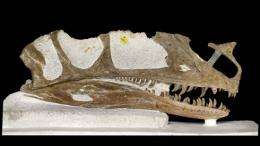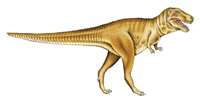T.rex's oldest ancestor identified

(PhysOrg.com) -- Remains of the oldest-known relative of T.rex have been identified, more than 100 years after being pulled out of a Gloucestershire reservoir, according to research published in the Zoological Journal of the Linnean Society today.
A near-complete 30cm skull in London’s Natural History Museum’s collection has been found to be a 165-million-year-old ancestor of T.rex, called Proceratosaurus.
Proceratosaurus was much smaller than T.rex, probably about 3m long, and lived 100 million years earlier. This new dinosaur gives scientists important clues about the early stages of the evolution of these fearsome predators.
A team of British and German scientists, including 2 fossil experts from London’s Natural History Museum, used computed tomography (CT) techniques to generate X-rays and then a 3D image of the delicate skull remains. This meant they could study its internal structure in minute detail.
They found that its teeth, jaws and braincase all closely resemble the structures found in the gigantic predator.
‘It was quite a surprise when our analysis showed we had the oldest known relative of T.rex,’ says Museum dinosaur expert, Dr Angela Milner.
‘We care for over 9 million fossils here at the Museum and this discovery highlights the importance of museum collections in current and future research. Fossils collected a century ago can now be studied again with the benefit of much greater knowledge of dinosaurs from around the world.’
The fossil is very well preserved, however, some of the bones were still covered in rock and had to be carefully cleaned before the skull could be fully examined.

‘This is a very fragile skull,’ says Museum fossil expert, Scott More-Fay, ‘so removing the rock, especially from around the teeth, was a delicate and time-consuming task that had to be done under a microscope, using very fine tools.’
The skull was uncovered during excavations for a reservoir close to Minchinhampton in Gloucestershire. In 1910, it was described as a new species of Megalosaurus.
The fossil was presented to the Natural History Museum in 1922 by F L Bradley, but its links to the most famous dinosaur family of all remained undiscovered until now.
Tyrannosaurus rex lived around 67 to 65 million years ago at the end of the dinosaur era in the Cretaceous period, and is a member of a larger group, called Tyrannosauroidea, after its most famous member.
Dr Oliver Rauhut from the Bavarian State Collection for Palaeontology and Geology in Munich said, ‘This is still one of the best-preserved dinosaur skulls found in Europe. It is really surprising that it has received so little attention since its original description.’
And, there are many possibilities to discover and identify new species using techniques such as CT modelling, as Dr Rauhut explains, ‘I’m sure that many more tyrannosaurs are still out there to be found. I think we have just scratched the tip of the iceberg so far.’
More information: Zoological Journal of the Linnean Society
Provided by Natural History Museum



















